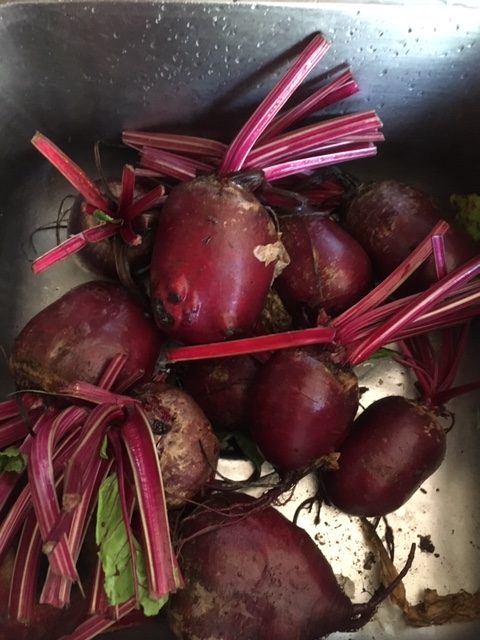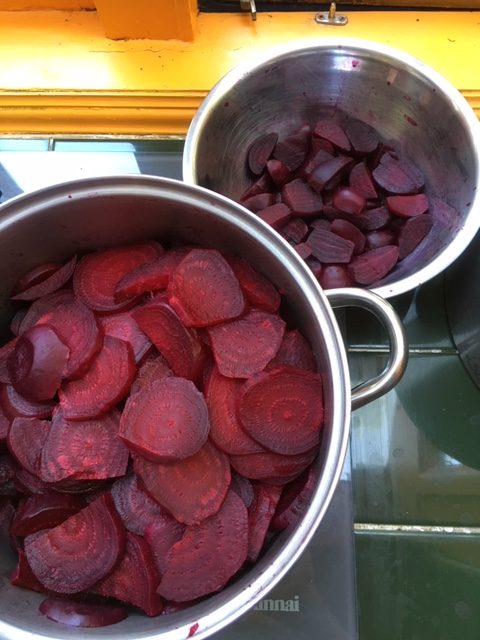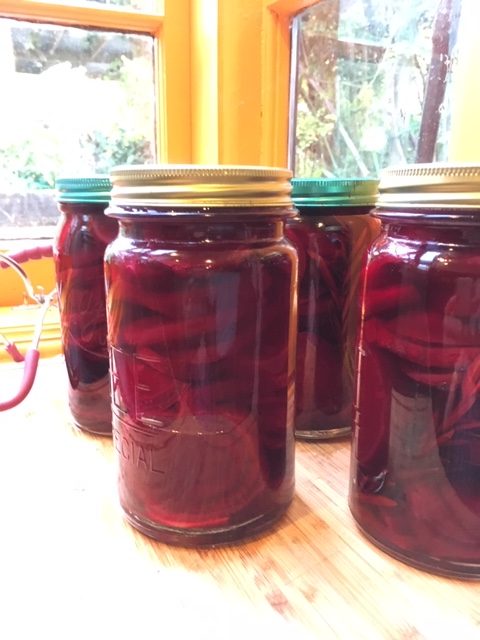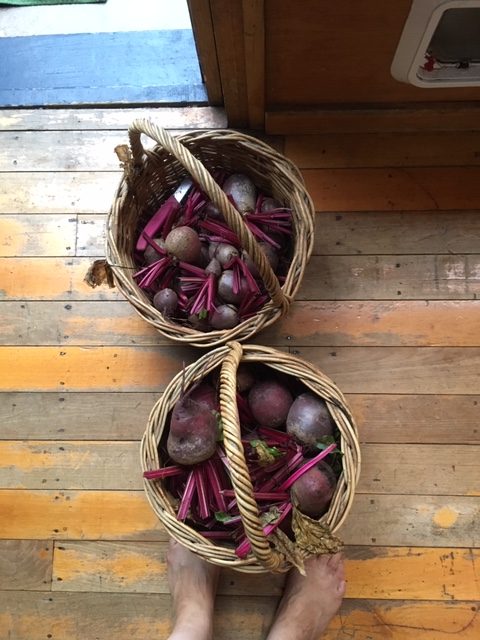This summer we had an excellent crop of beetroot. Grown from seed and planted into a relatively new garden bed they quickly grew fat. I decided to pickle most of them as I didn’t want them to suddenly bolt in this extreme summer heat. I left some in the ground, stored some in the fridge and apart from the many we have already eaten roasted, grated or boiled I pickled and preserved 7 & 1/2 kilos. That translated into seven of the 1 litre old style agee jars.

They are super delicious. I went through lots of different recipes and put together something that suited our tastes and preferences. I added fresh ginger and rosemary to each jar and popped some pickling spice into the vinegar brine for about 5 minutes only as I didn’t want the spices to overpower the natural earthy taste of the beetroot.
If you are processing less beetroots just scale down the recipe. Exact measurements are not that Important as long as you have at least a 2 vinegar to 1 water ratio. This is important to kill any bad bacteria. Most recipes use heaps of sugar but I didn’t here and it was definitely a perfectly good flavour. It’s always better to have an excess of vinegar brine that not to have enough. Store any extra in the fridge and use another time.
Ingredients; 7 1/2 kgs beetroots, plain salt, 8 cups vinegar, (I used half cider half white) 4 cups water (one of these is the liquid the beets are cooked in), 1/2 cup fesh lemon juice, 2/3rds cup brown sugar, fresh ginger, fresh rosemary sprigs, whole pickling spice.
Method; Prepare your jars. You can use classic agee jars and seals or pre-used jars with pop down lids. Wash jars and lids in hot soapy water. Dry with a clean tea towel and put to one side.
Now wash your beetroot leaving at least 1 inch of stalk and the root intact. If you cut into the beetroot now it will bleed it’s wonderful colour out into the water. Because I had so many beets and roughly small, medium and large sized I divided them into 3 pots and cooked the sizes separately. Cover the beets with boiling salted water and cook until still firm. I wanted them to be al dente and not soft and squishy. It’s quite important not to overcook. The small ones cooked in no time while the massive ones took much longer. This way I could skin, trim and halve/quarter the smalls whilst the others were still cooking. The medium and larger beets were sliced. Make sure to keep aside some of the water for the brine.

Its much easier to peel the beets while they are still hot. Place them into the sink, run them under a little cold water and you can slip the skin off easily. In the end I managed one jarful of the smaller halved beets. Remember they will get more cooking at the end in the water bath. Now the beets are ready and waiting so we can prepare the vinegar brine.
Into a pot pour the vinegars, water and saved beetroot water, sugar and lemon juice. Bring to the boil and simmer for 10 minutes. I wrapped some whole pickling spices in a little muslin bag which I left in the brine for only a few minutes before removing. Meanwhile prepare your canning pot. I have a huge old pot (with a lid) On the bottom fits my round wire cake rack. This stops the jars from coming into direct contact with the heat at the base of the pot and potentially cracking. You can also purchase an Agee simmer mat from Stevens stores. I’m heading off tomorrow to get one as I’ve got a lot of preserving ahead of me in the next few months. Hot water bath preserving is easy but it can seem daunting. Go here if you want to understand some of the protocols for this method. If you have the appropriate equipment it’s easier..I’ve just bought myself a jar lifter eureka! Half fill your big pot with hot water from the kettle but make sure it’s only hot, not boiling. When we put the jars into the water bath we don’t want them to crack. Once they are in we top up with boiling water to cover the jars by at least 1 inch
Time to fill the jars with the beets. Firstly put a rosemary sprig up against the inside of each jar and a few peeled slices of ginger at the base. Now pack your beets in pushing down and jiggling the jar gently to fill all the space. Leave about 1/2 inch head space clear at the top of the jar, making sure the rosemary is below the head space as well. Bring the vinegar brine back to a simmer then slowly pour into each jar again leaving 1/2 inch of head space. Use a clean cloth to wipe the top lip of the jar as any debris no matter how minuscule will prevent the seal from working. Place on the seal and a screw band. (or screw your pop down lids if this is what you are using) Tighten but not too tightly as the air needs to escape through the seal before it hermetically seals.
Place your jars into the water bath. Cover with more water (hot) cover the pot with the lid and bring to the boil. Make sure the jars don’t touch as this can cause them to crack/break. Once the water is boiling, time no more no less than 10 minutes keeping the water boiling. After 10 minutes turn off the heat and wait for another 10 minutes before you remove your jars form the water bath. This is when the jar lifter comes in very handy! No more scalded fingers 🙂

Place the hot jars on a board or a cloth and leave for at least 12 hours before removing the screw bands. If the lids have popped down this means the jars are safe to store in the pantry otherwise they will need to be stored in the fridge and eaten within a month or so. Enjoy:)

fat beets and gardeners feet.